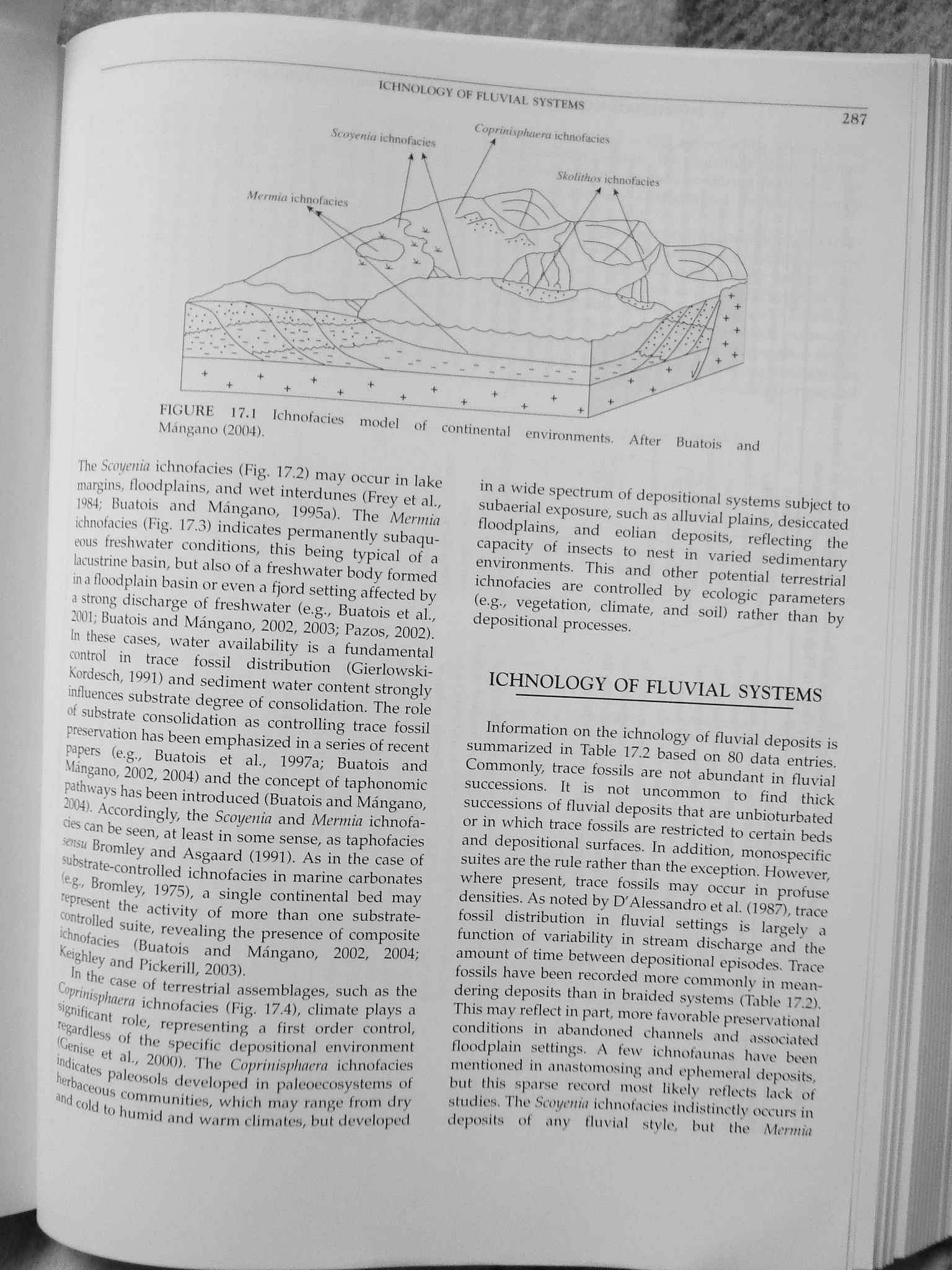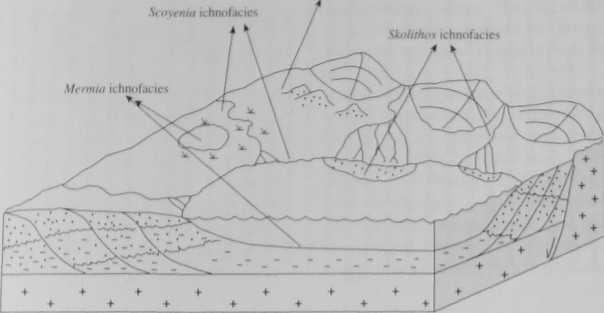dsc08810 (2)

287
ICHNOLOGY OF FLUVIAL SYSTEMS
Coprinisphuera ichnofacies

FIGURĘ 17.1 Ichnofacies model of Continental environments. After Buatois and Mangano (2004).
The Scoyenin ichnofacies (Fig. 17.2) may occur in lakę margins, floodplains, and wet interdunes (Frey et al., 1984; Buatois and Mangano, 1995a). The Mermia ichnofacies (Fig. 17.3) indicates permanently subaqu-eous freshwater conditions, this being typical of a lacustrine basin, but also of a freshwater body formed ina floodplain basin or even a fjord setting affected by a strong discharge of freshwater (e.g., Buatois et al., 2001; Buatois and Mangano, 2002, 2003; Pazos, 2002). In these cases, water availability is a fundamental control in tracę fossil distribution (Gierlowski-Kordesch, 1991) and sediment water content strongly influences substrate degree of consolidation. The role of substrate consolidation as controlling tracę fossil preservation has been emphasized in a series of recent papers (e.g., Buatois et al., 1997a; Buatois and Mangano, 2002,2004) and the concept of taphonomic pathways has been introduced (Buatois and Mangano, 2004). Accordingly, the Scoyenia and Mermia ichnofa-cies can be seen, at least in some sense, as taphofacies sensu Bromley and Asgaard (1991). As in the case of substrate-controlled ichnofacies in marinę carbonates (e.g., Bromley, 1975), a single Continental bed may represent the activity of morę than one substrate-controlled suitę, revealing the presence of composite ichnofacies (Buatois and Mangano, 2002, 2004; Keighley and Pickerill, 2003).
In the case of terrestrial assemblages, such as the Coprinisphaera ichnofacies (Fig. 17.4), climate plays a significant role, representing a first order control, regardless of the specific depositional environment (Genise et al., 2000). The Coprinisphaera ichnofacies indicates paleosols developed in paleoecosystems of Herbaceous communities, which may rangę from dry and cold to humid and wnrm climates, but devełoped in a wide spectrum of depositional Systems subject to subaerial exposure, such as alluvial plains, desiccated floodplains, and eolian deposits, reflecting the capacity of insects to nest in varied sedimentary environments. This and other potential terrestrial ichnofacies are controlled by ecologic parameters (e.g., vegetation, climate, and soil) rather than by depositional processes.
ICHNOLOGY OF FLUYIAL SYSTEMS
Information on the ichnology of fluvial deposits is summarized in Table 17.2 based on 80 data entries. Commonly, tracę fossils are not abundant in fluvial successions. It is not uncommon to find thick successions of fluvial deposits that are unbioturbated or in which tracę fossils are restricted to certain beds and depositional surfaces. In addition, monospecific suites are the rule rather than the exception. However, where present, tracę fossils may occur in profuse densities. As noted by D'Alessandro et al. (1987), tracę fossil distribution in fluvial settings is largely a function of variability in stream discharge and the amount of time between depositional episodes. Tracę fossils have been recorded morę commonly in mean-dering deposits than in braided systems (Table 17.2). This may reflect in part, morę favorable preservational conditions in abandoned channels and associated floodplain settings. A few ichnotaunas have been mentioned in anastomosing and ephemeral deposits, but this sparse record most likely reflects lack of studies. The Scoyenia ichnofacies indistinctly occurs in deposits of any fluvial style, but the Mermia
Wyszukiwarka
Podobne podstrony:
dsc08814 (2) 289 ichnology ot fluvial systems ichnofacies socms to prt;vail in floodplain deposits o
dsc08808 (2) C H A P T E R17Irwertebrate Ichnology of Continental Freshwater EnvironmentsLuis Albert
dsc08829 (2) INYERTEBRATE ICHNOLOGY OF CONTINENTAL FRESHWATER ENVJRONMENTSBeaconrtes -Taenidium
dsc08829 (2) INYERTEBRATE ICHNOLOGY OF CONTINENTAL FRESHWATER ENVJRONMENTSBeaconrtes -Taenidium
dsc08809 (2) 286 17. INYERTEBRATE ICHNOLOGY OF CONTINENTAL FRESHWATER EN VIRONMENTS assemblages that
dsc08832 (2) 310 17. INVERTEBRATE ICHNOLOGY OF CONTINENTAL FRESHWATER ENVIRONMENTS may have inhibite
dsc08836 (2) i16 17. INVERTEBRATE ICHNOLOGY OF CONTINENTAL FRESHWATER ENVIRONMENTS are remarkably si
dsc08832 (2) 310 17. INVERTEBRATE ICHNOLOGY OF CONTINENTAL FRESHWATER ENVIRONMENTS may have inhibite
dsc08836 (2) i16 17. INVERTEBRATE ICHNOLOGY OF CONTINENTAL FRESHWATER ENVIRONMENTS are remarkably si
dsc08811 (2) ICHNOLOGY OF FLUYIAL SYSTEMS Coprimsphaera ichnofacies FIGURĘ 17.1 Ichnofades model of
dsc08826 (2) ICHNOLOCJY OF LACUSTRINE SYSTEMS 299 Brncken and Pieard, I 984; Squiros and Advocate, 1
dsc08826 (2) ICHNOLOCJY OF LACUSTRINE SYSTEMS 299 Brncken and Pieard, I 984; Squiros and Advocate, 1
The Innouation System ol a Tourist Enterprise - a Madei Approacii Model of syslcms
dsc08825 (2) 17. INV1 Hll HKMI lUINOl.lHJY OF CONTINHNTAl FRHSHWATKR ENYIRONMKNTS stratlfied, lim -
dsc08828 (2) 308 7. INYERTEBRATE fCHNOLOGY OF CONTINENTAL FRESHWATER ENYIRONMENTS Beaconites -Taenid
dsc08825 (2) 17. INV1 Hll HKMI lUINOl.lHJY OF CONTINHNTAl FRHSHWATKR ENYIRONMKNTS stratlfied, lim -
dsc08828 (2) 308 7. INYERTEBRATE fCHNOLOGY OF CONTINENTAL FRESHWATER ENYIRONMENTS Beaconites -Taenid
więcej podobnych podstron